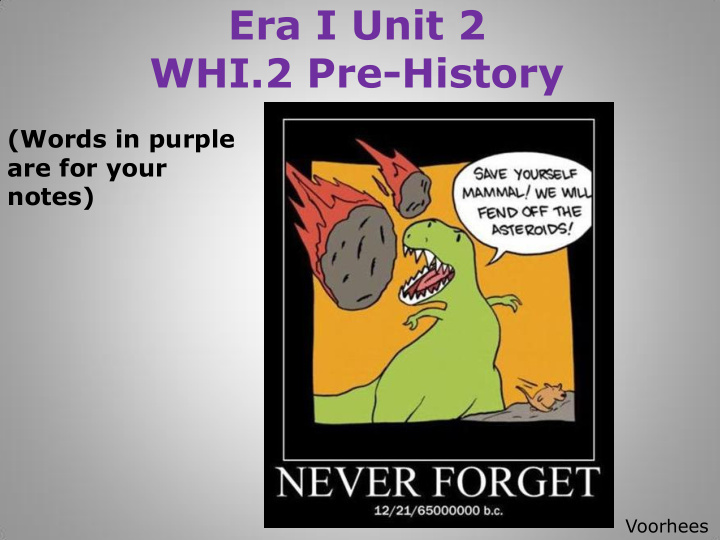



Era I Unit 2 WHI.2 Pre-History (Words in purple are for your notes) Voorhees
WHI.2 The student will apply social science skills to understand the period from the Paleolithic Era to the agricultural revolution b y • a) explaining the impact of geographic environment on hunter- gatherer societies; • b) describing characteristics of hunter-gatherer societies, including their use of tools and fire;
Stone Age Tools
prehistoric spear thrower
Intro: Prehistory= The Stone Age Once upon a time, Homo Sapiens emerged in • Africa between 100,000 and 400,000 years ago Homo Sapiens= humans • of today Two parts: • Old – New –
Migration of Humans
Natural Land Bridge to the Americas • Ice Age (Pleistocene Epoch) • much of the Earth’s water turned into ice • the sea level dropped as much as 300 ft • the shallow Bering Strait between Alaska and Siberia became a natural land bridge
Stone Age Homo Sapiens
Modern Homo Sapiens
Create a time line in your notes: • Dinosaurs 65,000,000 years ago • Homo Sapiens (humans) 500,000 yrs ago • Humans farming 10,000 years ago • Jesus of Nazareth 2,000 years ago • Industrial Revolution 300 years ago
I. Paleolithic= Old Stone Age A. Hunter-gatherer societies 1. hunted large game 2. gathered roots, nuts, berries, grasses
B. Environment= big part of their lives
C. NOMADS 1. moved around 2. followed the animals 3. had fire
4. lived in caves and temporary shelters
Paleolithic… 5. Lived in clans (groups of families) 6. Developed oral language (speaking) 7. Created cave art (culture)
WHI.2 The student will apply social science skills to understand the period from the Paleolithic Era to the agricultural revolution by • c) analyzing how technological and social developments gave rise to sedentary communities; and • d) analyzing how archaeological discoveries are changing current understanding of early societies.
II. The Neolithic Era= New Stone Age
A. The Agricultural Revolution 1. Farming! a. Technological and social advancements b. Stable communities c. 10,000 BCE (-ish)
Neolithic Era 2. Major step in the advance of civilization a. Permanent settlements b. Settled in fertile river valleys
Neolithic Era 3. Used advanced tools • “cold hammered” copper, gold, and lead 4. Made pottery 5. Developed weaving skills
III. Archeological discoveries A. Archeologists 1. study past cultures by locating and analyzing human remains, settlements, fossils, and artifacts. 2. apply scientific tests, such as carbon dating , to analyze fossils and artifacts.
Radiocarbon Dating • Radiocarbon dating is used to date fossils • All living organisms absorb radiocarbon • Radiocarbon decay can be measured
Stonehenge is an example of an archaeological site in England. It was begun during the Neolithic Age and completed during the Bronze Age.
B. Stonehenge 1. England 2. Neolithic Bronze Age
Aleppo
Aleppo (today)
Jericho
Jericho, Israel (8000 BCE; Fertile Crescent) • C. Aleppo and Jericho are examples of early cities in the Fertile Crescent studied by archaeologists.
Mount of Temptation Monastery overlooking Jericho
Çatalhöyük
D. Çatalhöyük is an example of a Neolithic settlement currently under excavation in Anatolia.
Megalithic structures
Druid Ceremony at Stonehenge
Malta
Carnac, France Callanish Stone Circle, Scotland
Easter Island, Chile
this class is about humans developing on the planet Earth
WHI.2 5 REVIEW QUESTIONS
1) Homo sapiens in Africa, between 100,000 and 400,000 years ago, • A lived in semi-permanent settlements. • B had an organized government. • C had complex tools. • D were nomadic.
2) Hunter gatherers had a life that was shaped by • A an agricultural society. • B the environment. • C a complex government. • D organized religion.
3) Neolithic societies • A were disorganized. • B relocated frequently in search of food. • C had simple tools. • D developed because of agriculture.
4) Scientists that study past cultures by analyzing human remains, fossils, and artifacts are called • A Paleontologists. • B Archaeologists. • C Psychologists. • D Entomologists.
5) An example of a site in England that was begun during the Neolithic Age and completed during the Bronze Age is • A Mesopotamia. • B Ganges. • C Stonehenge. • D Delian.
Okay… LET’S SEE HOW YOU DID
1) Homo sapiens in Africa, between 100,000 and 400,000 years ago, • A lived in semi-permanent settlements. • B had an organized government. • C had complex tools. • D were nomadic .
2) Hunter gatherers had a life that was shaped by • A an agricultural society. • B the environment . • C a complex government. • D organized religion.
3) Neolithic societies • A were disorganized. • B relocated frequently in search of food. • C had simple tools. • D developed because of agriculture .
4) Scientists that study past cultures by analyzing human remains, fossils, and artifacts are called • A Paleontologists. • B Archaeologists. • C Psychologists. • D Entomologists.
5) An example of a site in England that was begun during the Neolithic Age and completed during the Bronze Age is • A Mesopotamia. • B Ganges. • C Stonehenge . • D Delian.
The End
Recommend
More recommend